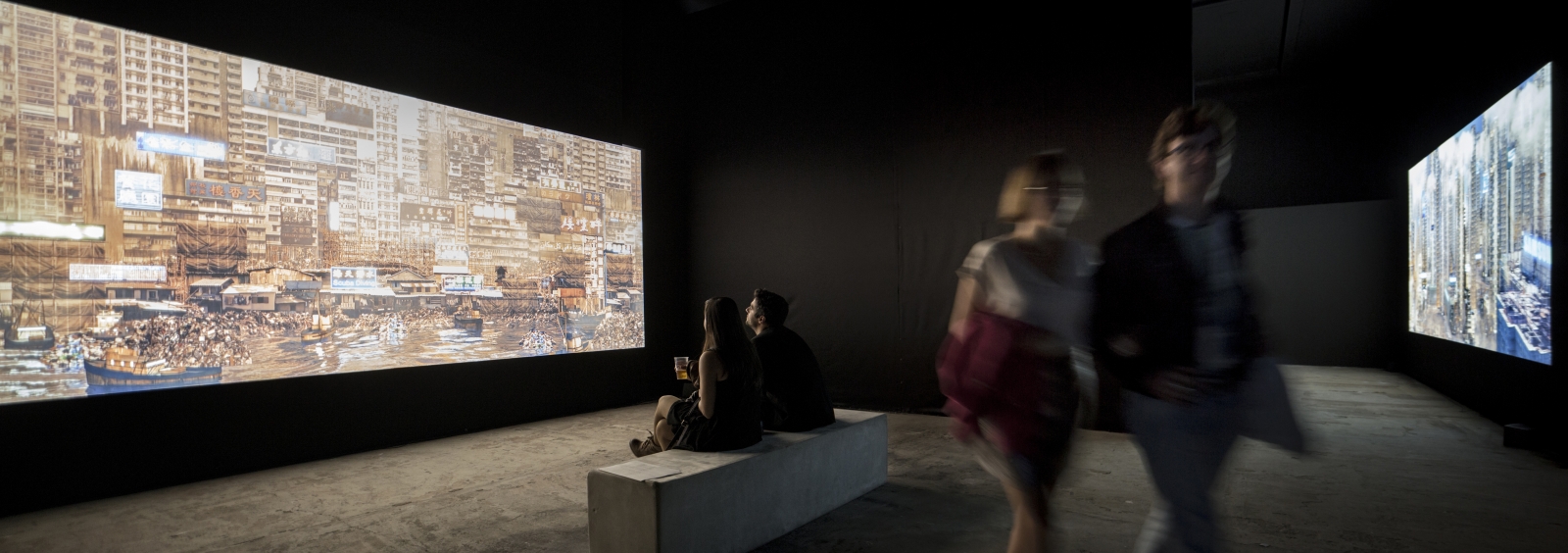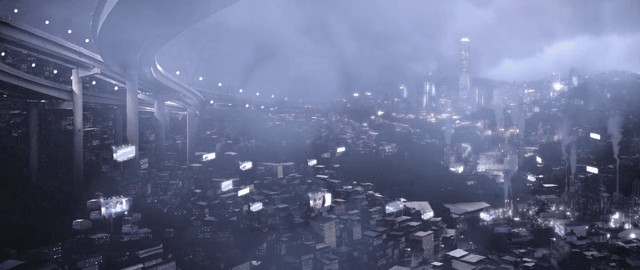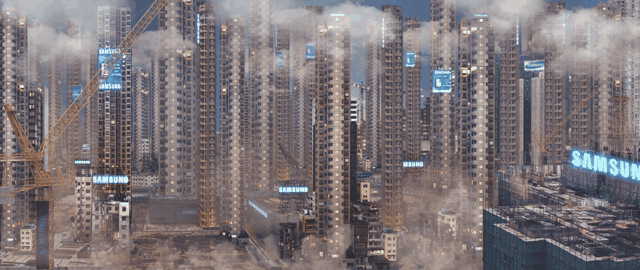What’s stranger: A vision of the future that’s completely foreign to you, or a vision of the future that’s recognisable but different enough to feel alien?
Some of the most challenging science fiction looks not at the distant, almost-recognisable future, but the near future — the liminal space between our right now and the vast stretch of years we can’t imagine. That’s the future we see in New City, a series of 5K animations and short stories by the writer and designer Liam Young.

New City installed in the gallery. Photo by Kristof Vrancken _Z33.
There’s a city built and operated by Samsung. There’s a town that exists solely to store the world’s data. And a floating nation that rides out the mega-storms on plastic buoys. Each city is based on a real urban phenomenon, but none of them are quite real yet. Instead, Young asked a different scifi author to compose a story for each future city, and to accompany these stories, he created a series of incredibly hi-res panoramic animations of each city, stitching together photos he took during expeditions to real-world cities.
These are the “animated skylines of the near future,” Young says. “In intricate detail they depict a speculative urbanism, an exaggerated version of the present, in which we can project new cultural trends, environmental, political and economic forces.”
Take Samsung City, for instance — a dreary and dystopian place where a couple worries they will get kicked out of their apartment for having an LG-brand smart TV, as told by author Tim Maughan. As ridiculous as that scenario sounds, it’s predicated on a very real phenomenon: Cities where Samsung has moved beyond TVs and smart phones and into real estate. “The city imagined what futures might result from a condition where tech brands become so big that they enter into all aspects of our lives,” Young explains.
What about “the Edgelands”, a New City described by author Jeff Noon as city of data, covered in wisps of song and fragments of text, where you might pay to meet the ghost of your digital self?

As Young tells me, it’s based on the very-much-a-real-town of Prineville, Oregon, where companies including Facebook, Google, Apple, and Amazon have all built massive data centres, exploiting cheap hydroelectric energy and tax breaks, as Young says. Written by Jeff Noon, the real-world Prineville takes on the dimensions of a darker future.
Then there’s the City in the Sea, a place that is half Water World and half real-life seasteading community. Written by Pat Cadigan, we’re dropped into a floating plastic world that is split apart to scatter its population during massive storms.

That element of the city is entirely speculative, but its economic basis is very real — just look at proposals like Blueseed, which wanted to built a floating community off the coast of California where tech workers without US visas could live and work. “The floating city sits in international waters, outside of typical jurisdictions and labour laws and becomes a multicultural city, supporting the megacompanies based on land,” says Young.
These are fascinating and disturbing visions, and the format Young chose makes them really easy to check out for yourself. Grab a pair of headphones, scroll down and press play on the video, and read each story as the sounds of its world wash over you.
Edgelands by Jeff Noon
I keep to the shadows of the township, fearful of being seen, a stranger.
The waste pits. This is where the digital world comes to die, and even at this time of night youngsters are digging for scraps of information, anything they can salvage and hope to sell on. Two of them are fighting over a morsel of text. I see the face of a one-time film star, a spectral mask floating in the air like insect silk.
A figure steps forward. Payment is made and I follow her in silence towards a row of sealed storage units. She breaks a padlock with a pair of cutters and then leaves me. My scanner bleeps. I’m close now, I can sense it. It’s dark inside and it takes my eyes a while to adjust. But then I see him, my symbiant. He’s sitting there, perfectly still, his body glowing with a faint blue light. My friend, I have not seen you in so long a time. His eyes flicker; I can only hope its recognition. Portions of his face are missing so I can see the hollowness within. It’s painful to witness. But the scars on his left wrist match my own exactly; we are both survivors of the same suicide. A few strands of fragile code in my scanner are the connecting tissue between us.
At the height of the digital era we all carried these phantoms with us: our downloaded selves given a semblance of life. We were symbiotic companions, each feeding off and supporting the other. But now, living in the aftermath of the system crash, we are bereft. Who would not do what I have done, following rumours of an almost perfect ethereal body found wandering at the city’s limits? A body with my name, and my face.
I take his hand and urge him to his feet. He’s weightless. It feels as though I’m touching at light itself, at colour. I retrace my steps, but a group of men are approaching. I fear these are his new owners, seeking to protect their asset. So I turn in the opposite direction. The men shout after us, but we are running now, away from the edgelands and into the fields beyond. A veil of mist closes around us.
I rest beside an abandoned caravan to catch my breath, and my ghost hovers before me. My face, his face. We touch our wrists at the old wound and fuse together, one inside the other. When I wake up some time later, lying on a fold-out bed, I have no sense at all of being separate. What now? We have yet to decide.
Looking back at the city’s skyline we see the ghosts rising from the outer regions, so many flickers of light, dots of colour, notes of music, images, words, fragments, drifting towards the vast shining edifices of the central zone and the financial district. The moon’s reflected blue sphere calls to them from each segment of polished glass.
Keeping Up Appearances By Tim Maughan
Duri drops the Samsung Galaxy SX phone onto the kitchen table, hears it chime softly as it makes contact with the paper-thin Samsung Qi SmartPower charging mat.
-Honey, what’s that cardboard tube in the hallway?
Sang’s voice comes back from the lounge, muffled by the low hum of the Samsung AHT24WGMEA/XSG air conditioner.
-That’s the TV, come and see-
-What?
-It’s the packaging the new TV came in. I’ve just hung it. Come in here and see!
Duri pushes open the door to an explosion of pixels the width of the room; an ultra high def orgy of thrown paint and 4K rainbow ejaculate soiling pristine whitespace. White turns to black, paint to fireworks, stars flicker and become city lights, a forest of pastel shaded, corporate branded condo-blocks emerging from the night, as the final strains of the orchestral score fade into the air-con’s never ending drone.
Sang waits until the TV’s start-up and calibration routine has finished before turning to Duri, idiotic childish glee filling approval-seeking eyes.
-Nice, huh?
-Yeah. It’s great. But why does it say LG on it?
[beat]
-Because… it’s made by LG?
-Move it. Now.
Sang looks confused, almost hurt.
-The TV?
-The packaging first. Get it out of the hallway. Bring it in here. Now.
-What? But they’re coming to get the recycling tonight-
-Exactly. Get it in here before anybody sees it.
Duri curses silently for trusting Sang with such an important consumer decision, anxiously glancing at the feed from the hallway’s Samsung SND-6011R dome camera via a Samsung SmartGear 7 Neo wristwatch.
-Christ, who knows who’s seen it already… I just hope nobody from the building standards committee is back from work yet…
-Baby…
-Don’t baby me. Are you trying to get us thrown out? Our lease is up for review in three months and you brought an LG TV into a Samsung housing block? What the hell will the neighbours say?
The City in the Sea By Pat Cadigan
Those silly yellow ducks came back from West GP, showing up right after one dog bell. Kids were so eager to see the Westies’ answering messages, they started jumping into the water, bobbing around with their floaties and tangling their tethers. Kids old enough to know better did, too. If I hadn’t had dog watch on the still, I mighta jumped in myself even though fourteen makes me a pre-adult.
I was just so bored. Four days outa the last seven, I’ve drawn still duty — not my dream job. I want tek stream. My mentor Shesea claims the fresh water distillery is the perfect place for an aspiring tekkie. But Klick’s mentor told her it’s vital for her and Klick wants meteorology. I guess all the mentors have to say that to fill the rota; somebody’s got to make sure the plastic keeps crying. I can’t wait for monsoon season and we fill up on rainwater. The sea can get pretty choppy and last year we had some scary-big waves. But the advantage of living in a plastic city is, you wibble and wobble but you never sink.
My mother rode out the KaiHuKa, short for Kai Hula Kahiko — “ocean hula.” The storm was so bad and lasted so long, they cut the Patch into modules with no more than a dozen people each. Mam was little then but she says she remembers every moment of being strapped into big puffy inflatables with her brother, and how he got seasick and yakked all the time, not just from chop but because he knew everyone’s pee got saved for filtration. The water tasted just like still; it was knowing where it came from. Uncle Jahid tells it vice versa. Me, I think it was both of them.
Afterwards, the pilots homed in on the Big Buoy signal to reunite and restore the Patch. Not everybody made it; some drowned and washed up on one island or another, and one just vanished altogether. Some people didn’t want to stay and cut themselves loose again. A few wanted to abolish the Patch altogether and tried to blow it up. I don’t know what they were thinking — stuff would just accumulate in the same place and without anyone to make use of it, it would just be a lot of crap for marine life to get tangled up in or choke on.
The official story is, they got deported, airlifted out by some island’s coast guard. But there are whispers that a pilot took them into the North Pacific Gyre and cut them loose with nothing but a good luck charm and five days’ worth of food and water — no smart-map, no radio, not even a beacon.
I wouldn’t really want to see another KaiHuKa but I kinda like the idea of cutting the Patch into pieces and rearranging them. Looking at the sat-receiver array and the solar collectors, I know I could position all of them better. I made a model out of beads and plastic remnants and showed it to my mentor. Shesea said I showed promise but I had a lot more still shifts to go before I got my hands on actual hardware.
And they say we’re a more flexible society than landlubbers. Sometimes I wonder.
